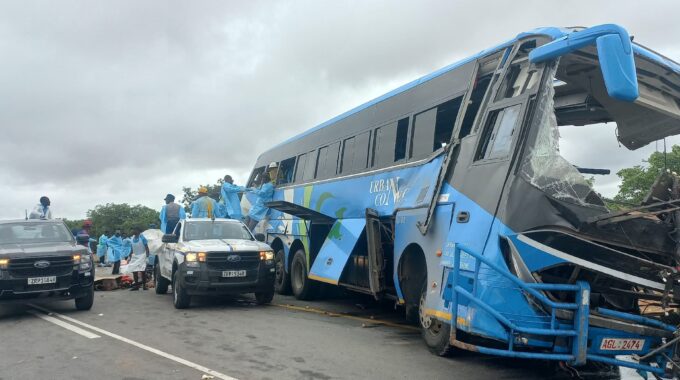The tragic events of recent days highlight a deadly reality on Zimbabwe’s highways: road safety, particularly with public service vehicles, is still a significant problem. A devastating crash on Thursday, which killed 25 people, involved an Urban Connect bus colliding with a truck carrying 34 tonnes of magnesium near Lutmba Tollgate on the Beitbridge-Masvingo Highway. Only days later, three more lives were lost when a Mandaza Bus collided head-on with a Glen View 2 High School bus on the Harare-Masvingo Highway near Beatrice. Another fatal road accident which occurred on the 15th February at the 156 kilometre peg along Harare-Mavingo road, Chivhu, killed two people, while 15 others were injured. These accidents are a grim reminder of the urgent need to address unsafe driving and inadequate safety measures on our roads.
In the two accidents, evidence suggests that unsafe overtaking played a crucial role. Witnesses from the Beitbridge crash report seeing the bus overtake another vehicle just moments before the collision. Similarly, the Saturday tragedy involved two buses engaged in dangerous overtaking maneuvers. These incidents raise the critical question, why is overtaking, often a reckless and deadly practice, still so common on our roads? Despite efforts by the Ministry of Transport and Infrastructure Development to curb public transport accidents through speed monitoring and bus route timings, it is clear that these measures are not enough to halt the growing number of road fatalities.
The stark reality is that bus drivers often face immense pressure to meet unrealistic travel schedules, a contributing factor to the unsafe overtaking and speeding observed. Unlike truck drivers, who typically operate under less time-sensitive conditions, bus drivers are often pushed by both their employers and passengers to drive faster. The recent crashes underscore the need for stricter oversight and better enforcement of speed limits for buses. Additionally, the quality of bus driver training must be examined. Most bus drivers are trained in urban areas, yet it is on high-speed highways where they face the most danger. Expanding training to focus on highway driving and ensuring drivers understand the risks of high-speed overtaking could make a significant difference in preventing future accidents.
By Ruvarashe Gora
Another critical factor is the safety of passengers during an accident. In the Beitbridge collision, many of the victims sustained severe head injuries, especially those who died before reaching the hospital. It is likely that these injuries could have been mitigated, or even avoided, if passengers had been wearing seatbelts. While it is mandatory for passengers in cars to wear seatbelts, this requirement is not enforced on buses, despite the fact that every passenger is seated. The introduction of seatbelt requirements on intercity buses, along with strict enforcement, would significantly improve survival rates during crashes. Given that intercity buses already have seats for every passenger, the addition of seatbelts and consistent safety protocols would not be overly difficult to implement.
Countries with better road safety records invest heavily in training for bus drivers. These countries require drivers to pass more rigorous tests, pay them better, and hold them to higher standards of conduct. In Zimbabwe, it is essential to consider implementing similar practices. Upgrading the bus driver’s licensing system to include better training for highway driving, enforcing stricter regulations on alcohol use, and suspending licenses for minor infractions could help make a meaningful impact on road safety. Furthermore, regular retesting should be mandatory to ensure that drivers maintain high standards of safety.
While the Ministry of Transport has made strides in regulating public transport, the tragic accidents of the past week show that more must be done. To prevent future disasters, Zimbabwe must focus on both improving driver training and ensuring stricter enforcement of traffic regulations. Moreover, introducing mandatory seatbelt use on buses and implementing additional safety measures will go a long way toward saving lives. These efforts, combined with better oversight and stronger penalties for unsafe practices, will help create a safer road environment for all Zimbabweans. The time for action is now.








Comments